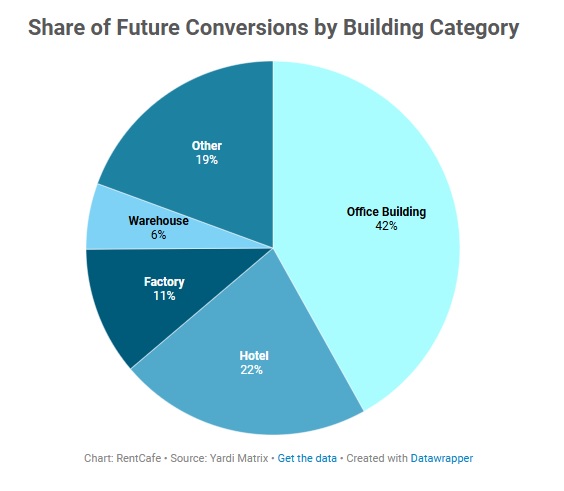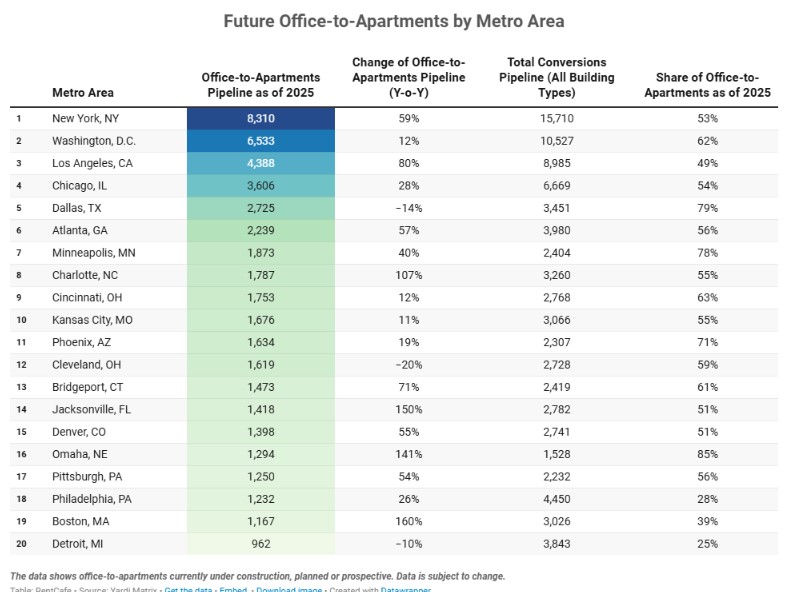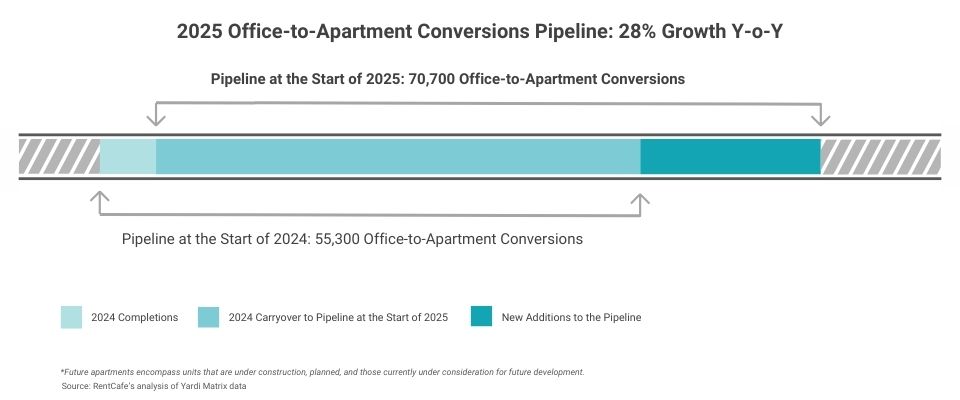Office-to-apartment conversions hit record high in 2025; even younger buildings are being repurposed

May 3, 2025 — The office-to-apartment conversion niche is growing on all fronts: Not only has the number of apartments converted from office buildings more than tripled since 2022, but the conversion pipeline grew by 28% in one year alone (from 2024 to 2025). Plus, these conversions are increasingly targeting younger office buildings, finds a new report from RentCafé (part of Yardi Systems).
RentCafé’s annual report tracks the pipeline of apartments converted from former office spaces, which has now reached an astounding 70,700 units in the pipeline — more than triple the 23,100 units converted in 2022.
Check out the hotspots of conversion and the key trends:
- The conversion pipeline has grown by 28% year-over-year in 2025, comprising 51,630 units carried over from the pipeline at the start of 2024 and 19,021 new conversions.
- New York has the biggest office-to-apartment conversions pipeline (8,310 units), followed by last year’s #1, Washington, D.C. (6,533 units); Los Angeles in third place (4,388 units); Chicago (3,606 units); and Dallas (2,752 units).
- In 16 of the top 20 metros, more than half of all adaptive reuse projects involve office-to-apartment conversions. Four metros stand out with shares exceeding 70%: Phoenix (71%); Minneapolis (78%); Dallas (79%); and Omaha, NE (85% — marking the largest share nationwide).
- There’s an increasing focus on repurposing modern buildings: Newer office buildings constructed between the 1990s and 2010s now represent 1.27% of the completed conversions. However, their share is expected to grow significantly, with their share set to rise to 7%.
- Office conversions now represent 42% of all the 169,000 apartments emerging from future adaptive reuse projects — up from 38% in 2024. Nationwide, 14.8% of all office buildings are deemed suitable for conversion, according to CommercialEdge’s Conversion Feasibility Index.
- Office-to-apartment conversions have more than tripled, growing from 23,100 units in 2022 to 70,700 units in the pipeline in 2025.
- Modern buildings constructed between the 1990s and 2010s are becoming more common in conversion projects. While they accounted for just 1.27% of completed conversions, their share is projected to rise to 7%.
- According to CommercialEdge’s Conversion Feasibility Index, 14.8% of all office buildings in the U.S. are suitable for conversion.

Additionally, here are some of the most notable conversion projects across the country, each set to bring hundreds of much-needed apartments to their respective cities:
- In New York City, a standout project is the transformation of Pfizer’s former global headquarters at 219 E 42nd St., which is expected to create 536 rental units.
- A key conversion in Washington, D.C., is the Universal Buildings project at 1825-1875 Connecticut Ave. NW. The property — totaling more than 1 million square feet — will be transformed into The Geneva, a residential complex containing 525 new apartments with at least 69 affordable units.
- In Los Angeles, the 3rd biggest office conversion hub in the country, a significant project is the ARCO Tower redevelopment, which will transform the 33-story office building at 1055 Seventh St. into brand-new apartments.
- One major project in Chicago is 30 N LaSalle St., where 432,000 square feet of space will be revamped into 432 new apartments, including 130 affordable units.
- In Dallas, the Bryan Tower stands out as a key project to watch: Built in 1973 and purchased by Woods Capital in 2022, the 1.1-million-square-foot glass tower will be transformed into 425 new apartments.
Read the annual report tracking office-to apartment conversions at RentCafé.

